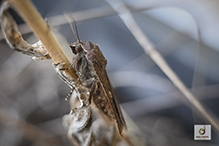large yellow underwing
(Noctua pronuba)
Conservation • Description • Habitat • Ecology • Distribution • Taxonomy
|
|
||||||||||||||||||
Description |
Large yellow underwing, also called European yellow underwing, is a large, exotic, migratory moth. It is native to Europe and North Africa west to India. It was accidentally introduced into Halifax, Nova Scotia around 1979. Since then, it has spread rapidly. It now occurs throughout the United States and southern Canada. In the U.S. it is abundant and widespread from the northeast to the upper Midwest, south along the Appalachian Mountains, and west of the Rocky Mountains. It is uncommon to absent in the southeast and in the Great Plains. It is common in Minnesota. The caterpillars are generalist feeders. They feed on the young leaves of many species of grasses, forbs, and shrubs. Adults are active from mid-June to mid-September. They are found in a very wide variety of habitats, including woodlands, savannas, grasslands, meadows, and urban areas. They may migrate great distances. Adults are 1 3⁄16″ to 1⅜″ (30 to 35 mm) in length and have a 1¾″ to 2⅜″ (45 to 60 mm) wingspan. Moth size is often given in terms of forewing length, which in this case is 13⁄16″ to 1″ (21 to 26 mm). The forewing is long, moderately narrow, and variably colored. The background color varies from pale reddish-brown, orangish-brown, tan, or gray, to dark brown or dark reddish-brown. The subterminal (ST) line is pale. Just before the ST line there is a pair of small black spots near the leading edge (costal margin). The spots are often fused together. The other transverse lines are slightly darker or missing. There is often a pale streak on the costal margin on the basal half of the wing. A large, round spot (orbicular spot) in the upper median area may be colored like the background and obscure, or pale and contrasting. A larger, kidney-shaped spot (reniform spot) in the lower median area has a thin inner outline and usually a dark interior. On most individuals it is distinct, on some it is barely visible. The hindwing is yellow or golden yellow. It has a broad, black, subterminal band, but is otherwise unmarked. There is no dark discal spot. The head, thorax, and abdomen are colored like the forewings. The antennae are slender and thread-like on both sexes. The eyes are bare. |
Size |
Total length: 1 3⁄16″ to 1⅜″ (30 to 35 mm) Wingspan: 1¾″ to 2⅜″ (45 to 60 mm) Forewing length: 13⁄16″ to 1″ (21 to 26 mm) |
Similar Species |
Habitat |
A very wide variety of habitats, including woodlands, savannas, grasslands, meadows, and urban areas. |
Ecology |
Season |
One generation per year: mid-June to mid-September |
Behavior |
Adults are active at night and will come to light, often in great numbers. |
Life Cycle |
Eggs overwinter. Caterpillars are active from April to June. |
Larva Hosts |
Many species of grasses, forbs, and shrubs |
Adult Food |
|
Distribution |
||
|
Sources |
|
| 7/22/2024 | ||
Occurrence |
||
Common |
||
Taxonomy |
|
Order |
|
Superfamily |
Noctuoidea (Owlet Moths and Allies) |
Family |
Noctuidae (cutworm moths and allies) |
Subfamily |
|
Tribe |
Noctuini |
Subtribe |
Noctuina |
Genus |
Noctua (yellow underwings) |
Subordinate Taxa |
|
|
|
Synonyms |
|
Agrotis pronuba Phalaena pronuba Rhyacia pronuba Triphaena innuba Triphaena pronuba |
|
Common Names |
|
European yellow underwing greater yellow underwing large yellow underwing large yellow underwing moth winter cutworm (larva) |
|
Glossary
Costal margin
The leading edge of the forewing of insects.
Orbicular spot
A circular spot or outline in the upper median area near the antemedial line on the forewing of many moths.
Reniform spot
A kidney-shaped spot or outline in the lower median area near the PM line on the forewing of many moths.
Visitor Photos |
||
Share your photo of this insect. |
||
This button not working for you? |
||
Ashley |
||
 |
|
|
Mike Poeppe |
||
 |
||
MinnesotaSeasons.com Photos |
||
|
||
|
||

Slideshows |
Large Yellow Underwing Moth |

|
About
Noctua pronuba |

Visitor Videos |
||
Share your video of this insect. |
||
This button not working for you? |
||
|
Other Videos |
||
AwA Yellow Underwing Caterpillar (Noctua pronuba) |
About
May 28, 2021 Take an Adventure with Ambrose to see a Yellow Underwing Caterpillar, which are commonly called “Cutworms”. During the movie there is a guest appearance by a Red and Black Spider walking along Ambrose’s arm! |
Facts About Large Yellow Underwing Moth | Huismoeder Mot | Nachtvlinder | Noctua pronuba | Info |
About
Jun 1, 2021 facts about Large Yellow Underwing Moth | Huismoeder Mot | Nachtvlinder | Noctua pronuba | Info | Species Profile I raised this Large Yellow Underwing Moth 🦋 from larvea to moth. Finally the pupa hatched. 😊 I wanted to set him free and it flew directly to the flowers on my terras. So i took the moment and made a informative video about the species. 🙂 |

Created: 6/19/2023 Last Updated: © MinnesotaSeasons.com. All rights reserved. |



